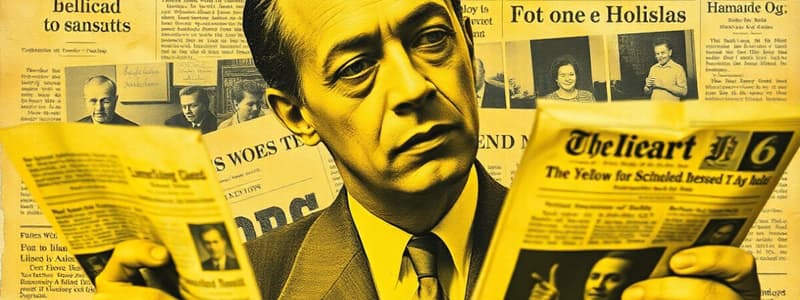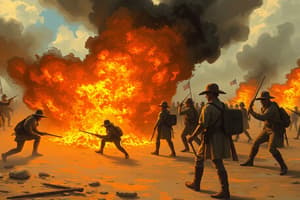Podcast
Questions and Answers
Which of the following best describes yellow journalism as exemplified by the New York Journal?
Which of the following best describes yellow journalism as exemplified by the New York Journal?
- Objective and unbiased reporting focused on international diplomacy and trade agreements.
- Sensationalized reporting that prioritizes attracting readers over factual accuracy, often with a nationalistic viewpoint. (correct)
- In-depth investigative journalism aimed at uncovering government corruption and corporate malfeasance.
- Meticulously researched articles that provide balanced perspectives intended to educate the public on complex social issues.
What was William Randolph Hearst's primary goal in purchasing the New York Morning Journal?
What was William Randolph Hearst's primary goal in purchasing the New York Morning Journal?
- To foster peace and understanding through careful reporting of global events.
- To promote unbiased and objective journalism.
- To compete with Joseph Pulitzer's *New York World* and become the best-selling paper in New York City. (correct)
- To provide a platform for intellectual debate and the arts.
How did the New York Journal use the Cuban conflict to increase its readership?
How did the New York Journal use the Cuban conflict to increase its readership?
- By downplaying the conflict to avoid alarming readers and maintaining objectivity.
- By providing neutral coverage of events in Cuba, focusing on economic impacts for U.S. businesses.
- By publishing academic analyses of the political situation in Cuba.
- By graphically portraying Spain's repression and exaggerating threats to U.S. citizens to stoke pro-war sentiment. (correct)
The story of Hearst's alleged involvement in the Maine explosion suggests what about the nature of yellow journalism?
The story of Hearst's alleged involvement in the Maine explosion suggests what about the nature of yellow journalism?
Which of the following was a consequence of the New York Journal's sensationalism?
Which of the following was a consequence of the New York Journal's sensationalism?
What distinguished Hearst's New York Journal from other newspapers of its time?
What distinguished Hearst's New York Journal from other newspapers of its time?
Which of the following elements was a key component of Hearst's yellow journalism strategy?
Which of the following elements was a key component of Hearst's yellow journalism strategy?
What action by the press most directly spurred the United States into declaring war on Spain?
What action by the press most directly spurred the United States into declaring war on Spain?
Flashcards
Yellow Journalism
Yellow Journalism
Sensational journalism used to attract readers through exaggerated and biased reporting.
William Randolph Hearst
William Randolph Hearst
William Randolph Hearst purchased the New York Morning Journal and used sensationalism to increase its circulation.
Joseph Pulitzer
Joseph Pulitzer
Joseph Pulitzer, publisher of the New York World, was Hearst's main competitor in the circulation war.
Sensationalism Tactics
Sensationalism Tactics
Signup and view all the flashcards
Journal Content
Journal Content
Signup and view all the flashcards
Journal's Nationalistic Stance
Journal's Nationalistic Stance
Signup and view all the flashcards
Cuban Cause
Cuban Cause
Signup and view all the flashcards
The Maine Explosion
The Maine Explosion
Signup and view all the flashcards
Study Notes
- During the Spanish-American War, the New York World and the New York Journal published jingoistic stories to attract more readers.
- Sensational journalism is known as yellow journalism.
William Randolph Hearst and Yellow Journalism
- In 1895, William Randolph Hearst, ambitious, bold, and rich, bought the failing New York Morning Journal.
- Hearst wanted to make the Journal the best-selling paper in New York City.
- The Journal had to compete with the successful New York World and Joseph Pulitzer.
- Hearst's plan and the ensuing circulation war with Pulitzer introduced yellow journalism.
- Yellow journalism is sensationalism in form and content.
- Hearst used huge banner headlines, melodramatic illustrations, and outlandish promotional schemes for the Journal.
- The Journal's content focused on lurid stories of crime, vice, and corruption, with a strong nationalistic slant.
- The Journal never missed an opportunity to instigate conflict and promote American patriotism.
- The Cuban cause was perfect for yellow journalism.
- In 1897 and 1898, Hearst's papers fueled public passions against Spain.
- Hearst's papers graphically portrayed Spain's repressive response to Cuban rebels.
- They created the idea that U.S. citizens were in extreme danger, leading to calls for military intervention in Cuba.
- The American battleship Maine's mysterious explosion in Havana became a rallying cry.
- Hearst's yellow journalism greatly contributed to the cry and chorus.
- Legend says that Hearst had the Maine blown up to cause the war.
- There is no evidence that Hearst did it, though the legend is easy to understand.
- Hearst told a correspondent in Cuba to supply his own stories if he couldn't find a war.
- Hearst's journalism led to a wide circulation of the Journal.
- The Journal’s success came but at the expense of the truth.
- Historians believe that the Journal's reporting was often exaggerated, biased, and sometimes dishonest.
Studying That Suits You
Use AI to generate personalized quizzes and flashcards to suit your learning preferences.




